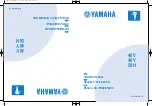
Radiocrafts
Embedded Wireless Solutions
RC2300DK/RC2301DK
©
2007 Radiocrafts AS
RC2300DK/RC2301DK Demonstration Kit User Manual (rev. 2.0)
Page 6 of 17
Connectors
The Demonstration Board is furnished with many connectors for easy access to all module
signals.
P5 bring out supply voltage, the DEBUG interface, a spare digital data I/O signal (Port 2) and
the RESET line.
P6 brings out digital and analogue I/O (Port 0). A 2.54 mm pitch pin-row can be mounted at
P6 if convenient.
P7 brings out digital I/O (Port 1) and the 32 kHz oscillator clock pins. A 2.54 mm pitch pin-row
can be mounted at P7 if convenient.
P8 is the DEBUG interface (pin compatible with the TI / Chipcon SmartRF04DB DEBUG
connector).
P9 is a connector for jumpers to connect/disconnect the on-board analogue sensors
preventing them loading the pins when not used.
P10 is a connector for jumper to connect VCC from the demonstration board back to the
programmer/EB.
For detailed signal description, please refer to the pinout shown in the data sheet.
Push buttons
The Demonstration Board is furnished with 6 push buttons connected to the following I/O
signals:
Demo Board
marking
RC2300 module pin
S1 P0.1
S2 P0.6
S3 P1.2
S4 P1.3
S5 P2.0
S7
RESET. Pressing this button will
activate the main RESET of the
module
LEDs
The Demonstration Board is furnished with one green power indicator LED, two LEDs
indicating UART activity as described above, and 2 LEDs connected to general I/O signals:
Demo Board
marking
LED color and RC2300 module pin
D3 Green:
P1.0
D6 Red:
P1.1
Accelerometer
The accelerometer can be used measure movements in 2-axis, it can also be used for tilt
measurement by measuring the earths gravitation. Accelerometer self test can be initiated by
shorting test point T1 to ground. The accelerometer has a 20 ms start-up time after power on.
See the Analog Devices ADXL321 datasheet for details about the accelerometer.



































